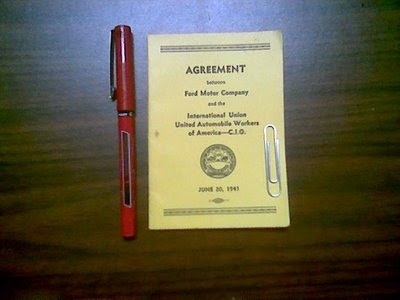Ford's Main Problem: The UAW's Crippling Job Classifications and Work Rules

1941 UAW-Ford contract

Ford's UAW contract has lots of them, governing who can and who can't perform specified tasks on the factory floor. So if a machine breaks down, an assembly line can come to a halt while everyone waits for the worker with the proper classification to arrive at the scene. If other workers nearby are perfectly capable of fixing the machine, well, that doesn't matter. The number of job classifications is less than it was a decade ago, but it's still far too many to maximize a factory's efficiency.
The classifications and attendant work rules are enforced by union bureaucracies—members of each plant's shop committee, grievance committee, health and safety committee, etc. They're all paid by the companies, as are their legions of corporate counterparts. One man's feather-bedding is another man's job.
All this begs a fundamental, and uncomfortable, question. Can a UAW-represented car company compete effectively, long term, with its nonunion competitors? At the very least, companies organized by the UAW have lots of extra costs to bear at their factories located in the U.S.
It's interesting, then, that Consumer Reports rates the quality of the four-cylinder Ford Fusion higher than the Toyota Camry and Honda Accord, and the Lincoln MKZ higher than its Acura and Lexus counterparts. The Fusion and MKZ are built in a factory without job classifications because it's in Hermosillo, Mexico, and isn't represented by the UAW. If Ford targets future expansion in Mexico, the recent contract vote will spell further decline for a union that, like Detroit's car companies, badly needs cultural change.
"How Ford Is Making Its Comeback: The news from Dearborn is sunny, except for the auto maker's labor relations," in today's WSJ by Paul Ingrassia
© 2025 Benzinga.com. Benzinga does not provide investment advice. All rights reserved.


